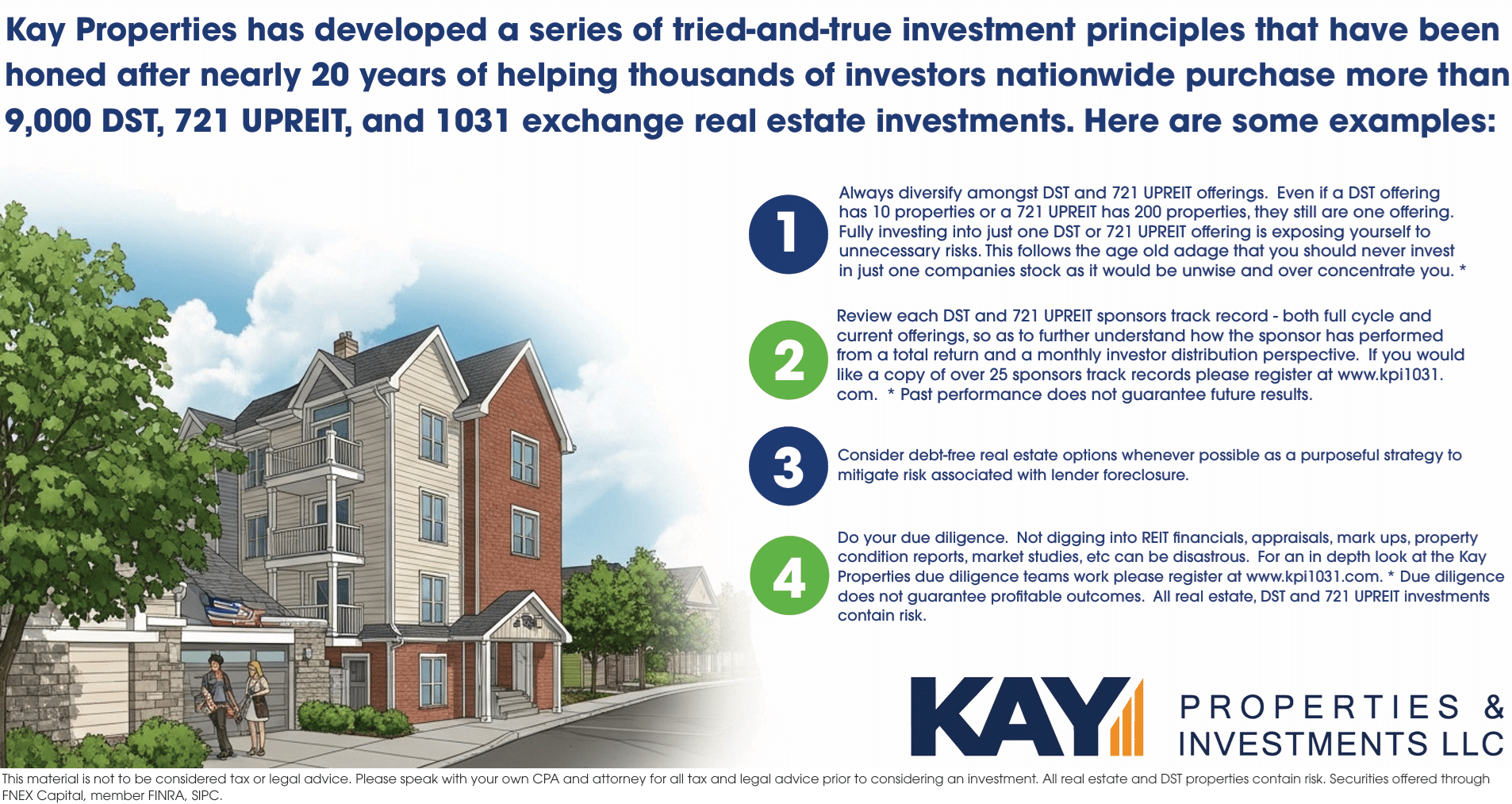“Currently, the appeal for 1031 exchange strategies such as DSTs has never been stronger,” said
Dwight Kay, Founder and CEO, Kay Properties and Investments
By
Dwight Kay, Founder & CEO
Kay Properties & Investments, LLC
When evaluating a
Delaware Statutory Trust (DST) investment for a 1031 exchange or direct cash purchase, investors often focus on the asset itself—location, tenant, lease structure, and potential returns. However, one of the most critical, and often overlooked, factors is the track record of the
DST sponsor. Taking a close look at how a DST sponsor company has performed in past offerings gives investors valuable insight into the sponsor’s ability to potentially deliver on their projections and navigate changing market conditions.

Quick note to investors: It is important to note that just because a DST sponsor company may have delivered solid returns to investors in the past on previous DST offerings, that there is no guarantee that future results will turn out similarly. This is why it is always important to:
- Understand that DST investments, like all forms of real estate investing, contain risks. These risks include that you can lose money when investing in DSTs and real estate.
- Read each DST properties Private Placement Memorandum (PPM) to further understand the business plan and risk factors of investing.
- Follow the Kay Properties tried and true investment philosophy for investing in DSTs that has been developed over nearly 20 years of helping thousands of investors purchase over 9,000 DST and 1031 real estate investments. This investment philosophy also has been developed by my personal DST investing experience of investing in over 100 different DSTs from many different DST sponsor companies.
Review the History of a Sponsor’s DST Full-Cycle Liquidity Events
Evaluate a DST sponsor’s full-cycle performance. This means that from the time a Delaware Statutory Trust offering is launched to when the DST property is ultimately sold on behalf of investors can potentially provide the clearest picture of how a sponsor executes its strategy. Did the DST sell at a profit? Did DST investors receive back 100% of their principal amount invested? What did the DST investment provide investors on an annualized return basis? What was the DST investment's Internal Rate of Return (IRR)? Did the DST investment lose money for investors? Of the current DSTs that the sponsor is managing, are they hitting their annual cash flow projections to investors or are they missing them?
Reviewing past full-cycle DSTs as well as the sponsor's current DST portfolio helps investors understand whether a sponsor consistently creates value and delivers outcomes aligned with initial expectations.
Study Operating Performance of DSTs to Monitor Projections vs. Reality
Even for DSTs that haven’t yet gone full cycle, performance can be assessed by comparing original cash-on-cash return projections to current actual monthly distributions. This snapshot offers a real-time look into how the sponsor’s underwriting is performing. If a DST was projected to provide a 5.5% annual return and is currently delivering only 4.2%, that discrepancy may signal overly optimistic assumptions by the DST sponsor company or challenges in asset performance. On the other hand, if returns are consistently on track, it can suggest a more disciplined and conservative approach.
Are the Underwriting Standards Aggressive or Conservative?
Another area that investors should evaluate is how a DST sponsor’s history looks over multiple offerings, paying particular attention to investment underwriting trends. If a sponsor frequently falls short of projected distributions, they may be using aggressive assumptions to make offerings appear more attractive. Conversely, if a sponsor consistently hits or exceeds their targets, it can be a sign of conservative underwriting and strong execution. These patterns can help investors determine which sponsors align with their personal risk tolerance and investment objectives.
Does the DST Sponsor Firm Demonstrate Transparency and Trust for Informed Decision-Making?
A transparent DST sponsor should be willing to share performance data for both full-cycle and operating DSTs. This includes annualized returns, distributions, and sale outcomes. Investors should ask for this information and review it closely. By doing so, investors can make more informed decisions and choose sponsors who have a proven history of aligning projections with performance. Again, past performance does not guarantee future results. Each investment is a stand-alone offering with its own set of risk factors. Investors are encouraged to read the DST investments PPM to further understand the risks of investing.
A DST sponsor's track record does not guarantee future results—but it’s one of the best tools investors have to evaluate potential DST sponsors. Reviewing a sponsor’s track record helps paint a clearer picture of how they perform under real-world conditions. In the world of real estate investments, projections are common but results vary, due diligence into a sponsor’s track record and history could make the difference between a potentially sound investment and a disappointing one.
At Kay Properties, we have compiled a comprehensive list of DST sponsor company track records. This includes performance data on both full-cycle and currently operating DST offerings across multiple sponsors. If you are an investor interested in reviewing these track records, please register at
www.kpi1031.com to gain access.


